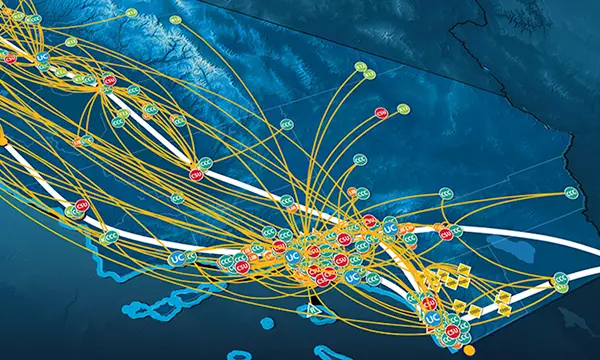- About
- Network
- Community
- Initiatives
- News
- Events
- Blog
- Publications

Engaging the Minds We Need

Innovation frequently happens in the liminal spaces between disciplines, where different perspectives collaborate and create new insights into seemingly intractable problems, some of the most pressing of which are global climate change, economic development, and public health.
But what happens when millions of vitally needed imaginations and perspectives – these minds – have no access to the cyberinfrastructure that makes global collaboration possible? That was the topic of discussion of a panel at the fall CENIC 2022 Conference, The Minds We Need: Towards a National Strategy for Cyberinfrastructure. The panel convened leaders in innovation and national networking, all with extensive experience in engaging underrepresented communities in STEM.
Larry Smarr, panel moderator and professor emeritus at UC San Diego, opened the discussion by highlighting high-performance cyberinfrastructure’s ability to erase the barriers of distance and access, observing that, “Talent is everywhere, but it doesn’t always have the capability of participating. That’s what the networking revolution is all about.”
“It’s appropriate we’re having this conversation at a CENIC conference,’ added Smarr, “because CENIC is one of the most diverse regional optical networks in the nation with K-12 schools, libraries, top-tier research universities, and cultural institutions all sharing the network.”

The panelists highlighted strong cases for the powerful roles played by Historically Black Colleges and Universities (HBCUs), Hispanic-Serving Institutions (HSIs), Minority Serving Institutions (MSIs), and Tribal Colleges and Universities (TCUs) in increasing the participation of historically-underrepresented minds and thus making real headway on today’s critical global challenges.
Richard Alo, PhD, Dean of the College of Science and Technology at Florida Agricultural and Mechanical University (FAMU), has spent his career in minority-serving institutions. “The problems, issues, and barriers for those who have been underrepresented are well understood and documented,” said Alo. “Today the challenge is to connect our institutions with top-tier research universities to mine the talent within our MSIs.”
Alo cited the creation of the Pacific Research Platform (PRP), an extensive high-performance research cyberinfrastructure, with CENIC and its pilots. The PRP’s outreach to MSIs such as FAMU led to its transition to the National Research Platform, which seeks to further expand cyberinfrastructure-enabled collaboration among MSIs and top-tier research institutions.
Download report "The Missing Millions"
“Regional high-speed and optical networks can help create the community our students need to excel and contribute their talents,” said Alo.
Ana Hunsinger, Internet2’s VP for Community Engagement echoed that statement and focused on the impact of the Minority Serving Cyberinfrastructure Consortium (MS-CC) in driving those connections. The MS-CC is the result of an NSF CI Center of Excellence Demonstration Project, awarded towards the end of 2021. Its stated mission is to promote advanced cyberinfrastructure (CI) capabilities on the campuses of HBCUs, HSIs, TCUs, and other MSIs.
“After working with the Consortium for less than a year, it was clear we needed to make a bolder proposal to the NSF to bolster our approach to engaging the 'missing millions' in this nation,” said Hunsinger.

Within a year of the pilot project, the Consortium’s work led to an additional NSF award to increase and accelerate cyberinfrastructure-centric research at MS-CC campuses. The funding will support both equipment and people needed to engage in a more robust effort of building an engaged national community focused on science and technology education.
One of the top leaders in data science and its importance for solving society’s biggest challenges is Ilkay Altintas, PhD, of the San Diego Supercomputer Center. Altintas noted that tomorrow’s challenges require all minds to be connected if we want to ensure relevance for the outcomes of leading-edge science.
“Broadband is a foundational infrastructure for an engaged society,” said Altintas. “And we need active translational engagement strategies to ensure we have the workforce that can translate technology into meaningful solutions for our society.”
Altintas particularly highlighted the need for research cyberinfrastructure to engage all perspectives in “use-inspired science” – research driven by specific needs. Often, the needs experienced by historically underrepresented communities are different from those experienced by the majority, with perspectives driving research in critical directions.

Larry Smarr concluded the panel by emphasizing his work with CENIC over the years and how much he learned as additional communities joined the network. “The only reason the National Research Platform was possible was because of all of you who are part of CENIC. That gave us the social base to start with, building it out campus by campus,” said Smarr. He then added, “I’m blown away at how many people, when you give them the opportunity, will log in and use something like this vast global set of computing and storage capability.”
“We know that talent is everywhere, but opportunity is not. We know that R&E infrastructure is essential for our scientific and engineering talent to flourish,” said Louis Fox, lead author of the Minds We Need and CEO of CENIC. “We propose that we invest in our R&E infrastructure, ensuring that it reaches every community through our diverse system of 3,900 accredited, degree-granting higher education institutions, and ensuring that there is a bridge to opportunity wherever there is talent. These are investments in inclusion, innovation, and competitiveness.”
Learn more about how to engage with the Minds We Need initiative, and the power of the National Research Platform.
Watch the presentation video and download the slides.
Related blog posts
The Big Game Is Big Data: How CENIC and the California Research and Education Network Support Member Athletics
When Fresno State needed to connect to Pac-12 Enterprises to broadcast a live football game over CBS, the Chancellor's Office reached out to CENIC for what Pac-12 later called the smoothest turn-up they've ever experienced.
Enabling Network-Based Collaboration Around the World: A Tour of CENIC and Partner Network Maps
On the Network Maps page at the CENIC website, you’ll find maps of all the networks, peering facilities, and exchanges to which CalREN connects, showing how thousands of CENIC member institutions connect to CalREN and to colleagues all over the globe.


